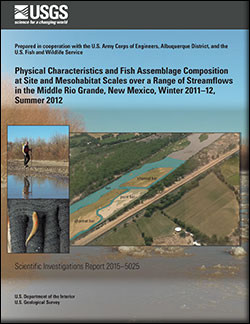
Product Details
- Product Number
- 329002
- Series
- SIR-2011-5205
- Scale
- NO SCALE
- Alternate ID
- SIR-2011-5205
- ISBN
- 978-1-4113-3350-5
- Authors
- JAMES J DUNCKER
- Version Date
- 01/01/2012
- Regions
- IL
- Countries
- USA
- Media
- Paper
- Format
- Printed but Unbound
Additional Details
- Description
-
Abstract
The State of Illinois’ annual withdrawal from Lake Michigan is limited by a U.S. Supreme Court decree, and the U.S. Geological Survey (USGS) is responsible for monitoring flows in the Chicago Sanitary and Ship Canal (CSSC) near Lemont, Illinois as a part of the Lake Michigan Diversion Accounting overseen by the U.S. Army Corps of Engineers, Chicago District. Every 5 years, a technical review committee consisting of practicing engineers and academics is convened to review the U.S. Geological Survey’s streamgage practices in the CSSC near Lemont, Illinois. The sixth technical review committee raised a number of questions concerning the flows and streamgage practices in the CSSC near Lemont and this report provides answers to many of those questions. In addition, it is the purpose of this report to examine the index velocity meters in use at Lemont and determine whether the acoustic velocity meter (AVM), which is now the primary index velocity meter, can be replaced by the horizontal acoustic Doppler current profiler (H-ADCP), which is currently the backup meter.
Application of the AVM and H-ADCP to index velocity measurements in the CSSC near Lemont, Illinois, has produced good ratings to date. The site is well suited to index velocity measurements in spite of the large range of velocities and highly unsteady flows at the site. Flow variability arises from a range of sources: operation of the waterway through control structures, lockage-generated disturbances, commercial and recreational traffic, industrial withdrawals and discharges, natural inflows, seiches, and storm events. The influences of these factors on the index velocity measurements at Lemont is examined in detail in this report. Results of detailed data comparisons and flow analyses show that use of bank-mounted instrumentation such as the AVM and H-ADCP appears to be the best option for index velocity measurement in the CSSC near Lemont. Comparison of the rating curves for the AVM and H-ADCP demonstrates that the H-ADCP is a suitable replacement for the AVM as the primary index velocity meter in the CSSC near Lemont.
A key component to Lake Michigan Diversion Accounting is the USGS gaging station on the CSSC near Lemont, Illinois. The importance of this gaging station in monitoring withdrawals from Lake Michigan has made it one of the most highly scrutinized gaging stations in the country. Any changes in streamgaging practices at this gaging station requires detailed analysis to ensure the change will not adversely affect the ability of the USGS to accurately monitor flows. This report provides a detailed analysis of the flow structure and index velocity measurements in the CSSC near Lemont, Illinois, to ensure that decisions regarding the future of this streamgage are made with the best possible understanding of the site and the characteristics of the flow.
- Height In Inches
- 11.000
- Length In Inches
- 8.500
- Two Sided
- Yes



